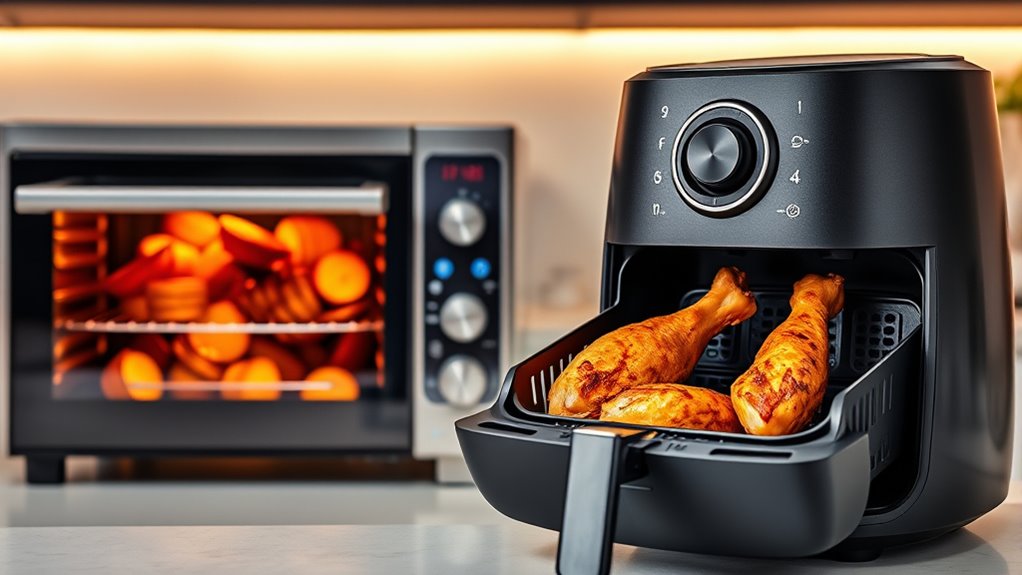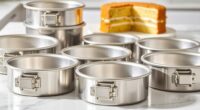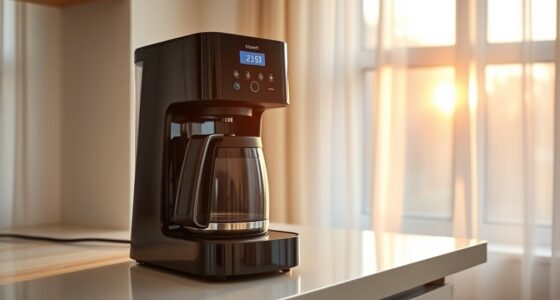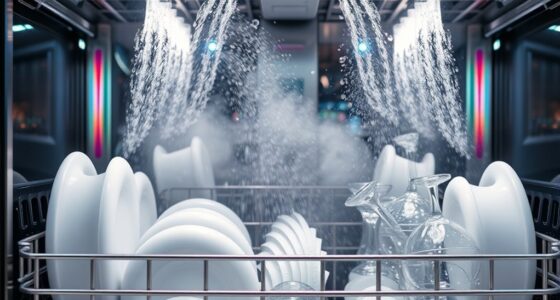Convection ovens and air fryers both use hot air to cook food quickly and evenly, but they aren’t the same. Convection ovens are larger, versatile appliances that handle big meals and multiple dishes at once, while air fryers are compact, designed for quick, small batches with crispy results that mimic deep frying. Their size, capacity, and primary uses differ. Continue exploring to understand how each appliance suits different cooking needs and preferences.
Key Takeaways
- Convection ovens are larger, versatile appliances with multiple racks, while air fryers are compact countertop devices designed for quick small batches.
- Both use hot air, but convection ovens roast and bake larger meals, whereas air fryers produce crispy textures similar to deep frying.
- Convection ovens are energy-efficient for big meals and multi-dish cooking, while air fryers excel at fast, small, crispy snacks with less oil.
- Convection ovens provide more even heat distribution across multiple dishes, unlike the localized rapid airflow in air fryers.
- The main difference lies in size, capacity, and typical use cases: convection ovens for larger, versatile cooking, air fryers for quick, healthier snacks.

When choosing between convection ovens and air fryers, it’s important to understand how each appliance works and what sets them apart. Both appliances use hot air to cook food quickly and evenly, but their design and intended use differ considerably. If you’re aiming for healthy cooking, knowing these differences can help you select the best option for your kitchen. Convection ovens are larger and resemble traditional ovens but incorporate a fan that circulates hot air around the food. This design allows you to cook larger batches, roast, bake, or broil with a more even heat distribution. Because convection ovens often have multiple racks, you can cook different foods simultaneously, making them versatile for various meal preparations. They’re generally energy efficient compared to traditional ovens, especially when used for longer cooking times or multiple dishes, since they reach temperature quickly and cook faster due to the circulating air.
Air fryers, on the other hand, are smaller, countertop appliances designed primarily for quick, crispy results, similar to deep frying but with substantially less oil. They use rapid air technology, which creates a high-velocity stream of hot air around the food, producing a crispy exterior while maintaining a tender interior. This method is excellent for healthy cooking because it requires little to no oil, reducing fat and calorie intake. Plus, air fryers heat up rapidly and cook food faster than traditional ovens, making them a time-saving option. Their compact size means they’re energy efficient for small batches, but if you need to cook larger quantities regularly, a convection oven might be more practical.
While both appliances promote energy efficiency, their benefits depend on your cooking habits. Convection ovens, with their larger capacity, can handle bigger meals and multiple dishes at once, making them suitable for families or meal prep. They tend to consume slightly more energy per use but make up for it by their multi-functionality and ability to cook larger quantities efficiently. Air fryers excel in quick, smaller meals and snacks, using less energy thanks to their compact size and rapid heating capabilities. They’re perfect if you’re looking for a faster way to prepare healthier meals with less oil. Ultimately, both appliances support healthy cooking, but your choice depends on your cooking style, kitchen space, and whether you prioritize larger meal options or quick, crispy snacks.
Frequently Asked Questions
Can an Air Fryer Also Function as a Convection Oven?
You might wonder if your air fryer can also serve as a convection oven. Many air fryers do include convection oven features, making them quite versatile. This means you can bake, roast, and even dehydrate with ease. While they share similar functions, keep in mind that air fryer versatility often focuses on quick, crispy results, whereas convection ovens typically handle larger batches and broader cooking options.
Which Appliance Consumes More Energy, Convection Oven or Air Fryer?
Think of your kitchen appliances as race cars—some are built for speed, others for efficiency. When comparing energy consumption, a convection oven typically uses more energy than an air fryer because it has a larger space to heat and maintain. The energy comparison shows that air fryers are usually more efficient, using less power for quick, crispy results. So, if saving energy is your goal, the air fryer wins the race.
Are There Specific Foods Better Suited for Convection Versus Air Frying?
You’ll find that some foods turn out better in a convection oven, where the broader cooking environment enhances food textures and offers greater cooking versatility. For example, baked goods like bread and casseroles benefit from even heat distribution. On the other hand, air frying excels with crispy textures, making it ideal for smaller items like fries or chicken wings. Choose your appliance based on the desired food texture and your cooking needs.
How Does Cooking Time Differ Between Convection and Air Frying?
You’ll notice that cooking duration varies between convection and air frying because of differences in how heat is distributed. With convection, you may need longer, but temperature adjustments can help speed things up. Air frying typically cooks faster at higher temperatures, so you should reduce the cooking time accordingly. Always monitor your food to prevent overcooking, and adjust times based on your specific appliance and the recipe.
Can I Use Convection Oven Settings on an Air Fryer?
You can use convection oven settings on your air fryer, but you should simplify and slightly adjust. Air fryers often operate at higher temperatures and shorter times. To avoid overcooking, tweak the temperature and keep a close eye on your food. Remember, convection oven settings aren’t directly interchangeable, so start with lower temperatures and monitor your meal to master the method.
Conclusion
So, now you see that convection ovens and air fryers aren’t quite the same, even if they share some similarities. Each has its own advantages depending on what you’re cooking and how you like to cook it. Do you really need the latest gadget for perfect results, or just a simple way to make your favorite meals? Ultimately, understanding their differences helps you make smarter choices in the kitchen. Isn’t it all about working smarter, not harder?









